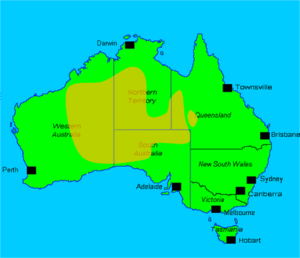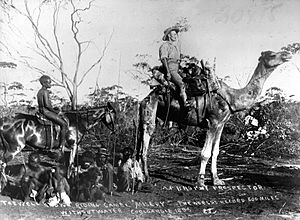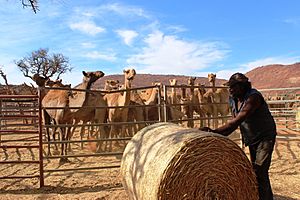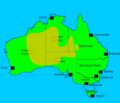Australian feral camel facts for kids
Quick facts for kids Australian feral camel |
|
|---|---|
 |
|
| Dromedary, Camelus dromedarius near Silverton, New South Wales | |
| Conservation status | |
| Scientific classification | |
| Kingdom: | |
| Phylum: | |
| Class: | |
| Order: | |
| Family: | |
| Genus: | |
| Species: | |
| Binomial name | |
| Camelus dromedarius Linnaeus, 1758
|
|
 |
|
| Spread of camels in Australia, shown in yellow | |
Australian feral camels are wild populations of dromedaries (one-humped camels). These camels were brought to Australia from places like British India and Afghanistan in the 1800s. They were used for transport and building during the time when people were settling the central and western parts of Australia.
In the early 1900s, cars and trucks started to replace camels. Many camels were then set free into the wild. This led to a large and fast-growing population of wild camels. By 2008, there were about one million feral camels in Central Australia. Experts thought this number could double every 8 to 10 years. These camels can cause serious damage to the environment and important cultural sites, especially when it's dry. In 2009, a program was started to manage the camel population. By 2013, the number of feral camels was estimated to be around 300,000.
Contents
History of Camels in Australia
Camels had been used successfully for exploring deserts in other parts of the world. The idea of bringing camels to Australia was first suggested in 1822 by a geographer named Conrad Malte-Brun. He thought camels would be great for crossing sandy deserts in Australia.
In 1839, Lieutenant-Colonel George Gawler, who was the second Governor of South Australia, also suggested importing camels. He believed they would be helpful for working in Australia's dry areas.
The first camel arrived in Australia in 1840. It was ordered from the Canary Islands. Most of the camels on that ship died during the journey, but one survived. This camel was named Harry. Harry was used by explorer John Ainsworth Horrocks in 1846 to search for new farming land in South Australia's dry interior. During this trip, Horrocks was accidentally injured by his gun when Harry moved. Horrocks later died from his injuries.
"Afghan" Cameleers and Their Camels
Australia's first big inland trip to use camels for transport was the Burke and Wills expedition in 1860. The Victorian Government brought in 24 camels for this journey. The first camel handlers, called cameleers, arrived in June 1860 from Karachi (which was then part of British India). They came to help with the expedition because, as the government said, "the camels would be almost useless unless they had their native drivers." These cameleers took care of the camels, loaded supplies, and found water.
From the 1860s onwards, small groups of mostly Muslim cameleers came to Australia. They worked in South Australia's inland farming areas. They earned good money by using camels to carry goods and wool bales. As they learned more about the Australian outback, many cameleers started their own businesses, importing and running camel trains.
By 1890, the camel business was mostly run by these Muslim merchants. They were often called "Afghans" or "Ghans," even though they came from many places like British India, Afghanistan, Egypt, and Turkey. It's thought that at least 15,000 camels and their handlers came to Australia between 1870 and 1900. Most of these were dromedaries, which are one-humped camels. A male camel could carry up to 600 kilograms (about 1,320 pounds). Camel trains could travel more than 40 kilometers (about 25 miles) in a day.
Special camel farms were set up in 1866 by Sir Thomas Elder and Samuel Stuckey in South Australia. There was also a government camel farm in Western Australia. These farms helped provide strong, healthy camels for the Australian camel trade for about 50 years.
Camels continued to be used for exploring the inland by many famous explorers. They were also used to build important projects like the Australian Overland Telegraph Line and to carry pipes for the Goldfields Water Supply Scheme.
After 1901, new laws made it harder for cameleers to enter Australia.
Camels Go Wild
When many cameleers left Australia in the early 1900s, and with the arrival of cars and trucks in the 1920s and 1930s, some cameleers let their camels go free. These camels were very good at living in the dry conditions of Central Australia. They became the ancestors of the large wild camel population we see today.
Camels and Aboriginal People
Some Aboriginal people still remember the first time they saw camels. An Aboriginal man named Andy Tjilari described seeing camels for the first time as a child. He and his family were surprised but then followed the camels, trying to copy them.
As the Afghan cameleers traveled through the inland, they met many different Aboriginal groups. They began to share skills, knowledge, and goods. Cameleers sometimes helped Aboriginal people by carrying traditional items like red ochre along old trade routes. They also brought new things like sugar, tea, tobacco, clothes, and metal tools to remote Aboriginal groups. In return, Aboriginal people taught the cameleers about desert water sources and plants. Some cameleers even hired Aboriginal men and women to help them on their long journeys. This led to lasting friendships and even some marriages.
From 1928 to 1933, a missionary named Ernest Kramer used camels to travel through Central Australia. He wanted to share his religious message. He often worked with an Arrernte man named Mickey Dow Dow, who was a cameleer, guide, and translator. They would give out sweets, tea, and sugar, and show pictures using a "magic lantern projector." For many Aboriginal people, this was their first experience of Christmas, linking camels, gifts, and Christianity.
By the 1930s, as cars replaced camels, Aboriginal people had a chance to learn camel-handling skills. They bought their own camels, which helped them travel more freely and be more independent. This continued until at least the late 1960s. A film called Camels and the Pitjantjara shows Pitjantjara men capturing and taming a wild camel to add to their herds. They then used camels to move a large group of people.
Camels also appear in Indigenous Australian art. You can see examples of this art in places like the National Museum of Australia.
Managing Feral Camels
Australia has the largest population of wild camels in the world. In 2008, there were thought to be over one million feral camels. This number could double every 8 to 10 years. By 2013, after efforts to reduce their numbers, the population was estimated to be around 300,000, growing by about 10% each year.
How Feral Camels Impact Australia
Impact on the Environment
Even though camels don't cause as much damage as some other introduced animals, they eat more than 80% of the available plant types. When there are more than two camels per square kilometer, they start to harm the environment. This is happening in many parts of the Northern Territory. Camels can also damage traditional food plants that Aboriginal people gather. While their soft feet don't cause much soil erosion, they can make sand dunes unstable. Wild camels also affect salt lake areas and can make waterholes dirty.
The National Feral Camel Action Plan listed these environmental problems:
- Damage to plants from eating and trampling.
- Stopping some plant species from growing.
- Eating rare and endangered plants.
- Damaging wetlands by making them dirty and trampling them.
- Competing with native animals for food and shelter.
Impact on Buildings and Property
Camels can cause a lot of damage to things like taps, pumps, and toilets when they are looking for water, especially during droughts. They can smell water from far away and are even attracted to moisture from air conditioners. They also damage fences and water points used for cattle. These problems are especially hard for Aboriginal and other remote communities, where fixing things is very expensive.
Economic Impact
The National Feral Camel Action Plan also mentioned these money-related problems:
- Costs for controlling and managing camels.
- Damage to fences, yards, and water sources.
- Camels competing with cattle for food and water.
- Cattle escaping because fences are broken.
- Destruction of traditional bush food resources.
Social Impact
The plan also listed social problems caused by camels:
- Damage to important cultural sites, like religious places, burial sites, and waterholes.
- Destruction of bush food resources.
- Changes in how people use their land and loss of chances to teach younger generations.
- Making natural areas less enjoyable.
- Interfering with native animals or hunting.
- Creating dangerous driving conditions.
- Causing problems in towns and safety worries near airstrips.
- Damage to remote Aboriginal communities and their buildings.
- Costs for communities due to traffic accidents.
Northern Territory Camel Cull, 2009
During a very bad drought in Australia in the early 2000s, thousands of camels died of thirst. The problem of camels coming into towns looking for water became very serious. The Northern Territory Government planned to remove up to 6,000 camels that were causing trouble in the community of Docker River. This plan was reported around the world and caused a lot of discussion.
National Feral Camel Action Plan, 2009–2013
The Australian Feral Camel Management Project (AFCMP) ran from 2009 to 2013. It was managed by Ninti One Limited and received money from the Australian Government. The project aimed to help landowners manage wild camels and reduce their impact on important environmental and cultural sites.
Many groups worked together on this project, including governments, Aboriginal land councils, and environmental organizations. They got permission from landowners to manage camels across a huge area. Different methods were used to remove camels, respecting the wishes of Aboriginal landowners.
By the end of the project in 2013, the wild camel population had been reduced by 160,000 camels. Most of these were removed by shooting them from helicopters. Some were gathered for pet meat. The project estimated that about 300,000 camels remained, with the population growing by 10% each year.
Some people in the Australian camel industry thought the wild camels should be used for meat or exported alive instead of being culled. They argued this would create jobs and reduce waste. However, challenges like the camels' health, high transport costs, and lack of facilities in remote areas made this difficult.
There is no ongoing government money for this program. Experts estimated that about A$4 million per year would be needed to keep the camel population at current levels.
2020 APY Lands Cull
Because of widespread heat, drought, and the 2019–20 Australian bushfire season, wild camels were moving closer to human settlements, especially remote Aboriginal communities. In the APY lands of South Australia, they were walking through streets, damaging buildings and property while looking for water. They were also harming native plants, making water supplies dirty, and destroying cultural sites. In January 2020, the South Australian Department for Environment and Water began a five-day cull. Professional shooters removed between 4,000 and 5,000 camels from helicopters, following strict animal welfare rules.
Camel Industry in Australia
Camel Meat
Camel meat is eaten in Australia. Some slaughterhouses process wild camels, selling the meat to places like Europe, the United States, and Japan. There are also companies that supply camel meat for pet food.
In 2011, a warning was issued about camel meat used in pet food. A study found that some dogs got sick from eating camel meat that contained a harmful substance called indospicine. This substance comes from certain plants that camels might eat.
Live camels are also sometimes sent to countries like Saudi Arabia and the United Arab Emirates. In these places, healthy wild camels are valued for their meat or for camel racing. Australia's camels are also exported for breeding or for tourist attractions in other countries.
Camel Milk
Australia has a growing camel milk industry. The first large camel dairy was set up in Queensland in 2015. There are now several smaller camel dairies across Australia. The Camel Milk Company in Victoria has grown a lot, from three wild camels in 2014 to over 300 in 2019. They export fresh and powdered camel milk to countries like Singapore, Thailand, and Malaysia.
The amount of camel milk produced in Australia has grown from about 50,000 liters (about 13,200 US gallons) in 2016 to 180,000 liters (about 47,500 US gallons) per year in 2019.
Tourism
Many camel farms offer rides or treks for tourists. You can find these at places like Kings Creek Station near Uluru, Calamunnda Camel Farm in Western Australia, and Pyndan Camel Tracks in Alice Springs. Camel rides are also popular on beaches, like at Victor Harbor and Cable Beach in Broome.
There are also two popular camel racing events in Central Australia: the Camel Cup in Alice Springs and the Uluru Camel Cup.
Images for kids
-
Dromedary, Camelus dromedarius near Silverton, New South Wales
See also
 In Spanish: Camello cimarrón australiano para niños
In Spanish: Camello cimarrón australiano para niños





